James Dow (2008)
Is Religion an Evolutionary Adaptation?
Journal of Artificial Societies and Social Simulation
vol. 11, no. 2 2
<https://www.jasss.org/11/2/2.html>
For information about citing this article, click here
Received: 01-May-2007 Accepted: 29-Jan-2008 Published: 31-Mar-2008
 Abstract
Abstract(1) Cognitive theories that postulate that religion is the manifestation of mental modules1 that have evolved for other purposes (Atran and Norenzayan 2004; Boyer 2001, 2003).
(2) Ecological regulation theories that postulate that religion is a master symbolic control system regulating the interaction of human groups with their environments, and, therefore, it has evolved as an adaptive mechanism with this function (Rappaport 1999).
(3) Commitment theories that postulate that religion is a system of costly signals that reduce deception and create trust and cooperation within groups (Irons 2001; Sosis 2004).
Ecological regulation theory and commitment theory propose that religion has evolved as an adaptive mechanism, while cognitive theory does not.
There is a growing consensus among social scientists that the capacity for religion is carried in the human brain and much of that capacity is there at birth (Wolpert 2006; McNamara 2006; King 2007); however, that brain does not have to understand its own adaptive workings. The rational brain has evolved to solve immediate problems of survival. It analyzes sensory input to find solutions to problems that the sensory organs detect in the environment. However, it has no need to analyze long-term evolution. Thus, the hidden evolutionary adaptiveness of religion is obscure to the rational brain. Evolution, itself, organizes long-term adaptations, and the rational brain does not deal with them.
Evidence for evolutionary adaptation can exist either as:
(1) a correlation between a behavior and a particular environment or as
(2) a valid model of an evolutionary processes that selects the behavior.
Sociobiology proposes that genes and culture do not evolve independently, on separated, isolated tracks. The neurobiology of human mental development makes them co-dependent, resulting in the process of gene-culture coevolution (Lumsden and Wilson 1981). Gene-culture coevolution in human beings appears to be based on gene-culture transmission, a process of organismic growth and development in which innate learning capacities respond to certain forms or types of cultural information in preference to others, demarcating the central tendencies around which cultural diversity plays (Lumsden 1999).
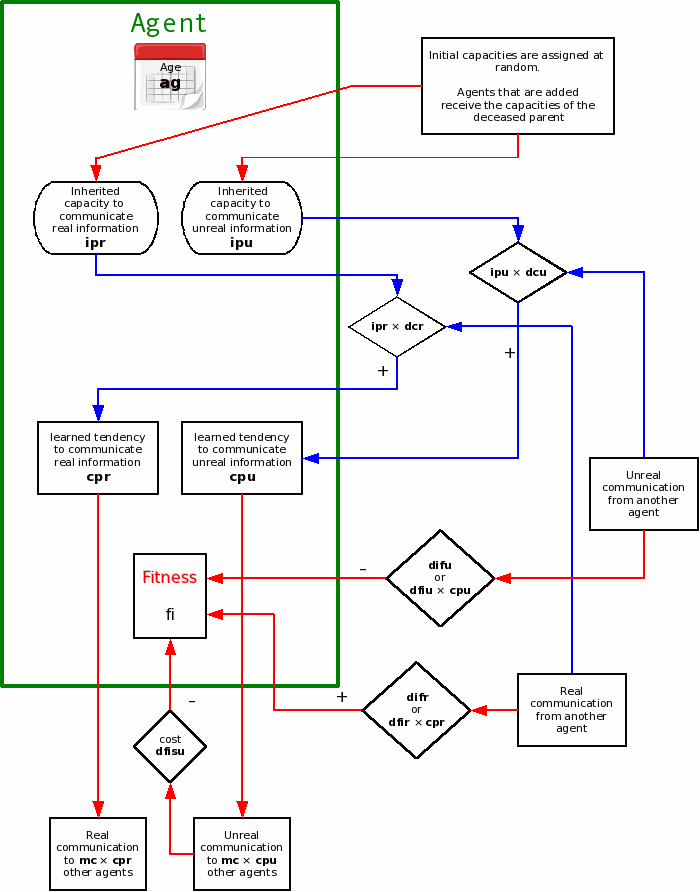
|
| Figure 1: Gene-culture effects on an agents behavior. Genetic effects in red. Cultural learning in blue. |
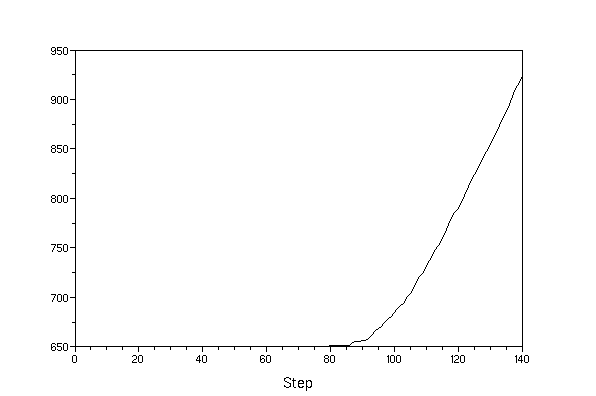
|
| Figure 2: Population increase in Case 2. |
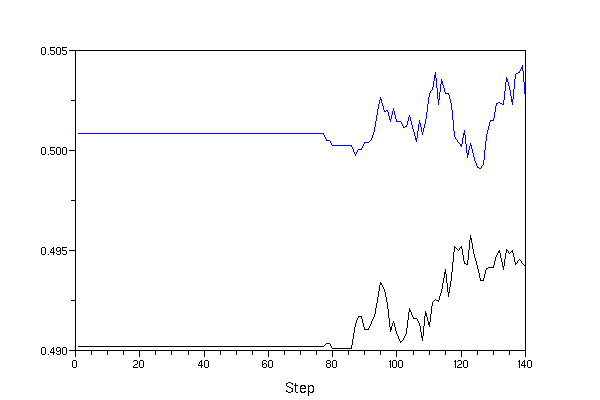
|
| Figure 3: The evolving means of real (black) and unreal (blue) communication capacities in Case 2 |
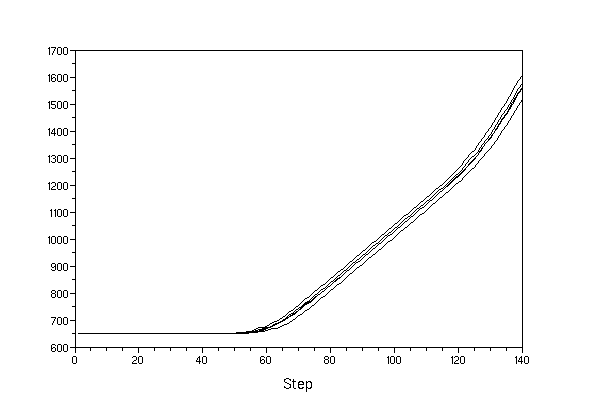
|
| Figure 4: Population increase in five runs of Case 2. |
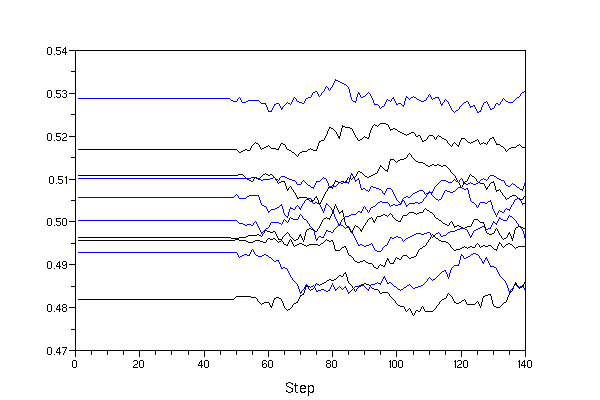
|
| Figure 5: The evolving means of real (black) and unreal (blue) communication capacities in five runs of Case 2. |
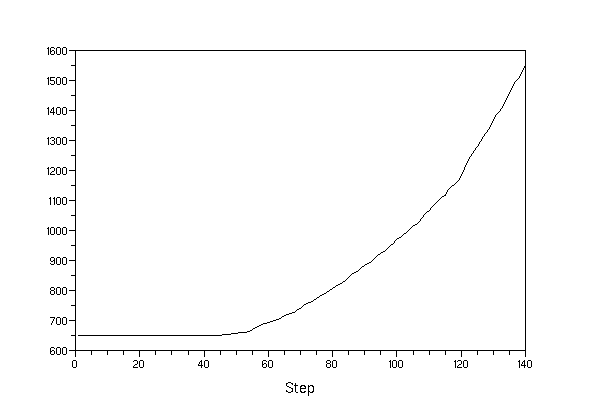
|
| Figure 6: The growth in population caused by better learning in Case 3. |
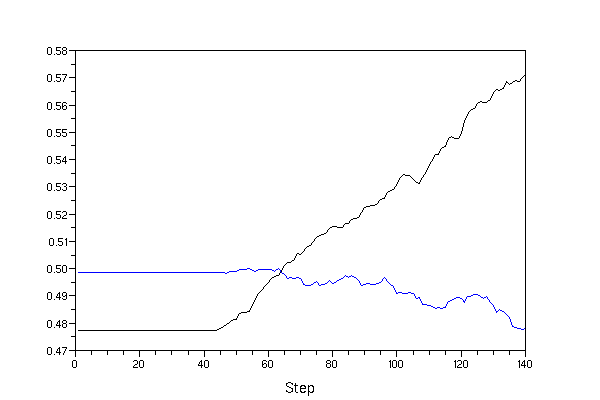
|
| Figure 7: The evolving means for real (black) and unreal (blue) communication capacities in Case 3. |
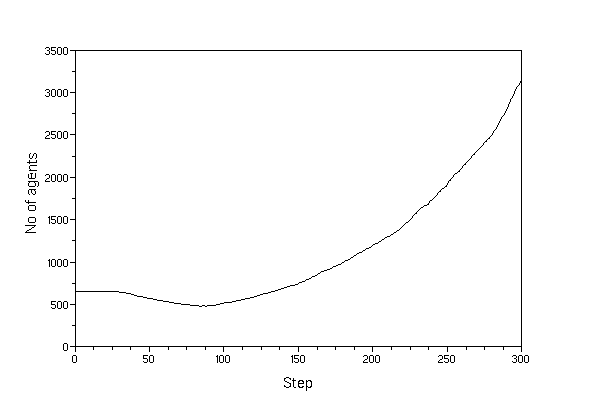
|
| Figure 8: Longer term population growth with more cost to costly signaling. |
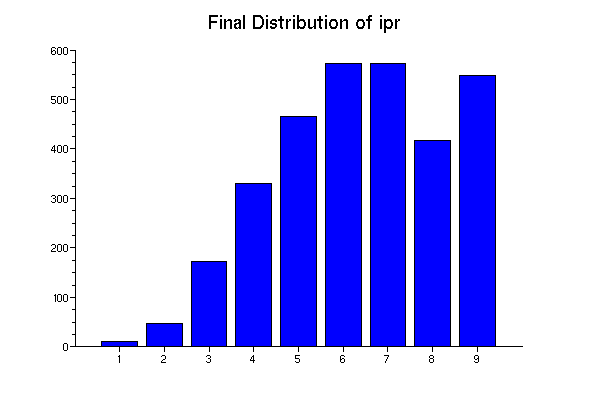
|
| Figure 9: Case 4: Final distribution of real communication capacity (ipr) with more cost to costly signaling. The probability ranges are in tenths. |
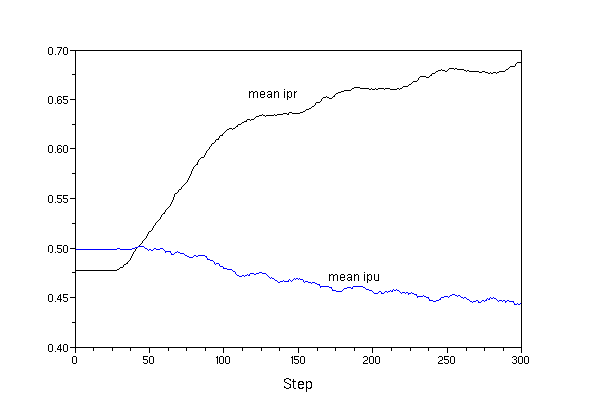
|
| Figure 10: The trend of means of the capacities to make real (black) and unreal (blue) communications in Case 4. |
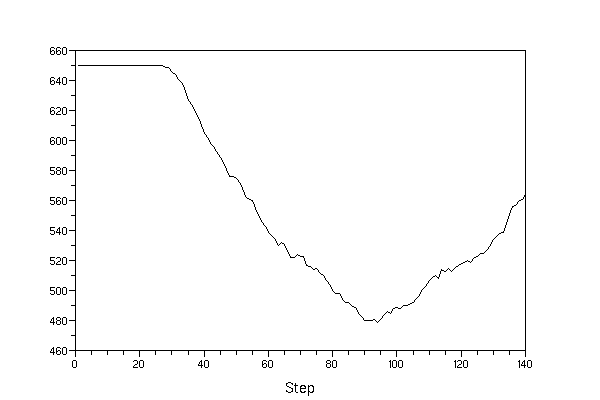
|
| Figure 11: Population decline and growth in Case 5. |
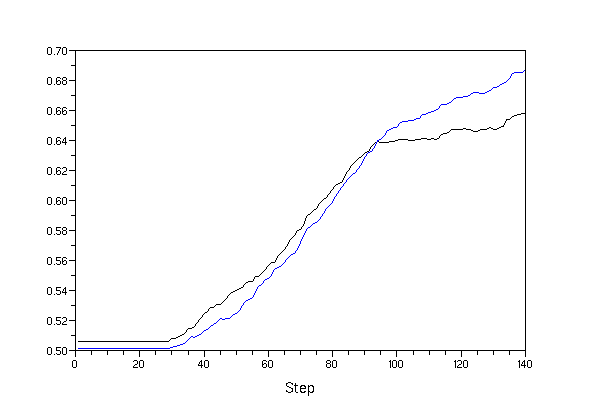
|
| Figure 12: The evolving selection of capacities for real (black) and unreal (blue) communications with the greenbeard effect in operation. |
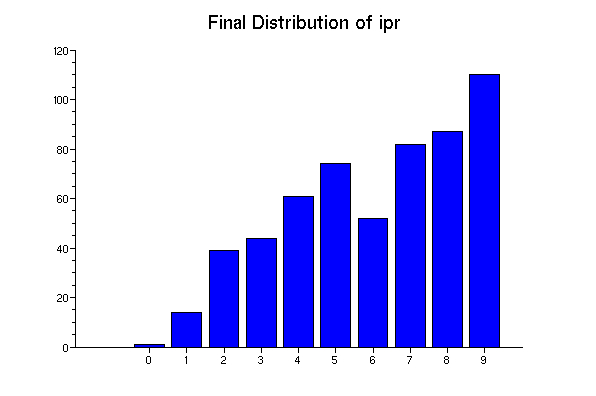
|
| Figure 13: The final distribution of the capacity for real communication (ipr) in Case 5. The capacity ranges are in tenths. |
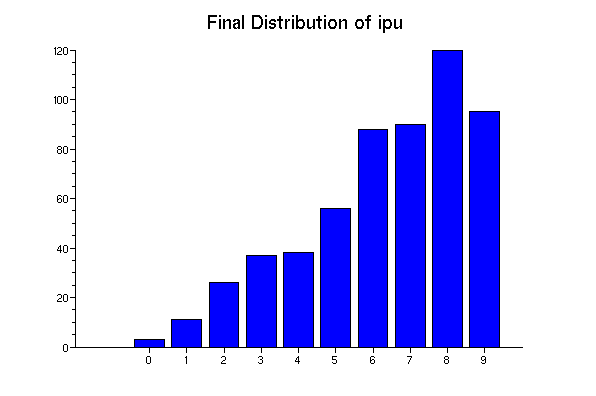
|
| Figure 14: The final distribution of the capacity for unreal communication (ipu) in Case 5. The capacity ranges are in tenths. |
The author acknowledges the help and encouragement received from Candace Alcorta, Richard Sosis, Lawrence Kuznar, and the editor and reviewers of the JASSS.
1. The term module is commonly used in evolutionary psychology to describe a pattern of heritable behavior aimed at solving a particular problem of survival in the evolutionary past (Barkow, Tooby, and Cosmides 1992).
| Run | Parameter set |
| 1 | ns = 140; ip1 = 10; le = 65; mc = 5; dcr = 0.00; dcu = 0.00; dcur = 0.00; dfir = 0.017; dfiu = -0.005; dfisu = -0.01; dp = 0; lr = 0; ur = 1; lv = 0; uu = 1; dist = 0; popgrow = 0; greenbeard = 0; mult = 0; cmr = 0.5; cmu = 0.5; icp = 0.2; |
| 2 | ns = 140; ip1 = 10; le = 65; mc = 5; dcr = 0.01; dcu = 0.01; dcur = 0.01; dfir = 0.012; dfiu = -0.005; dfisu = -0.01; dp = 0; lr = 0; ur = 1; lv = 0; uu = 1; dist = 0; popgrow = 0; greenbeard = 0; mult = 0; cmr = 0.5; cmu = 0.5; icp = 0.2; |
| 3 | ns = 140; ip1 = 10; le = 65; mc = 5; dcr = 0.01; dcu = 0.01; dcur = 0.01; dfir = 0.012; dfiu = -0.005; dfisu = -0.01; dp = 0; lr = 0; ur = 1; lv = 0; uu = 1; dist = 0; popgrow = 0; greenbeard = 0; mult =1; cmr = 0.5; cmu = 0.5; icp = 0.2; |
| 4 | ns = 300; ip1 = 10; le = 65; mc = 5; dcr = 0.01; dcu = 0.01; dcur = 0.01; dfir = 0.010; dfiu = -0.005; dfisu = -0.02; dp = 0; lr = 0; ur = 1; lv = 0; uu = 1; dist = 0; popgrow = 0; greenbeard = 0; mult =1; cmr = 0.5; cmu = 0.5; icp = 0.2; |
| 5 | ns = 140; ip1 = 10; le = 65; mc = 5; dcr = 0.01; dcu = 0.01; dcur = 0.01; dfir = 0.010; dfiu = -0.005; dfisu = -0.02; dp = 0; lr = 0; ur = 1; lv = 0; uu = 1; dist = 0; popgrow = 0; greenbeard = 1; mult =1; cmr = 0.5; cmu = 0.5; icp = 0.2; |
Download the program here.
View the program in the window below.
ALCORTA C S, Sosis R (2005) Ritual, Emotion, and Sacred Symbols: The Evolution of Religion as an Adaptive Complex. Human Nature, 16(4), pp. 323-359.
ATRAN S (2002) In Gods We Trust: The Evolutionary Landscape of Religion. Oxford: Oxford University Press.
ATRAN S and Norenzayan A (2004) Religion's Evolutionary Landscape: Counterintuition, Commitment, Compassion, Communion. Behavioral and Brain Sciences, 27, pp. 713-730.
BARKOW J H, Cosmides L, and Tooby J (Eds.) (1992) The Adapted Mind: Evolutionary Psychology and the Generation of Culture. New York: Oxford University Press.
BARRETT J L (2000) Exploring the Natural Foundations of Religion. Trends in Cognitive Sciences, 4(1), pp. 29-34.
BARRETT J L and Richert R A (2003) Anthropomorphism or Preparedness: Exploring Children's God Concepts. Review of Religious Research, 44, pp. 300-312.
BERGHAUS G (2004) New Perspectives on Prehistoric Art. Westport, CT: Praeger/Greenwood.
BOYD R and Richerson P J (2001) "The Evolution of Subjective Commitment to Groups: A Tribal Instinct Hypothesis." In R. Nesse (Ed.) Evolution and the Capacity for Commitment, pp. 186-220. New York: Russell Sage Foundation.
BOYD R and Silk J B (2006) How Humans Evolved, Fourth Edition. New York: W.W. Norton.
BOYER P (2001) Religion Explained: The Evolutionary Origins of Religious Thought. New York: Basic Books.
BOYER P (2003) Religious Thought and Behaviour as By-Products of Brain Function. Trends in Cognitive Sciences, 7(3), pp. 119-124.
BULBULIA J (2004a) The Cognitive and Evolutionary Psychology of Religion. Biology and Philosophy, 19(5), pp. 655-686.
BULBULIA J (2004b) Religious Costs as Adaptations that Signal Altruistic Intention. Evolution and Cognition, 10, pp. 19-42.
DAWKINS R (1976) The Selfish Gene. New York: Oxford Univ. Press.
DENNETT D (2006) Breaking the Spell: Religion as a Natural Phenomenon. New York: Viking Adult.
DORAN J (1998) Simulating Collective Misbelief. Journal of Artificial Societies and Social Simulation, 1(1)3. https://www.jasss.org/1/1/3.html
DOW J W (2006) The Evolution of Religion: Three Anthropological Approaches. Method and Theory in the Study of Religion, 18(1), pp. 67-91.
DOW J W (2007) A Scientific Definition of Religion. Anpere: Anthropological Perspectives on Religion http://www.anpere.net/ccount/click.php?id=13
DURHAM W (1991) Coevolution: Genes, Culture, and Human Diversity. Stanford, CA: Stanford University Press.
DURKHEIM, É (1912) Les formes élémentaires de la vie religieuse: Le systéme totémique en Australie, Livre I: Questions préliminaires. Chicoutimi, Québec: Bibliothéque Paul-Émile-Boulet de l'Université du Québec à Chicoutimi. http://classiques.uqac.ca/classiques/Durkheim_emile/formes_vie_religieuse/formes_vie_religieuse.html
FISHER R A (1958) The Genetical Theory of Natural Selection, Second Revised Edition. New York: Dover Publication.
FRANK S A (1998) Foundations of Social Evolution. Princeton, NJ: Princeton University Press.
FRANK S A (2006) "Social selection". In C. W. Fox and J. B. Wolf (Eds.) Evolutionary Genetics: Concepts and Case Studies, pp. 350-363. Oxford: Oxford University Press.
GOODY J (1986) The Logic of Writing and the Organization of Society. Cambridge: Cambridge University Press.
IRONS W (2001) "Religion as a Hard-to-Fake Sign of Commitment". In R. Nesse (Ed.) Evolution and the Capacity for Commitment, pp. 292-309. New York: Russell Sage Foundation.
ISAAC G (1976) Stages of Cultural Elaboration in the Pleistocene: Possible Archaeological Indicators of the Development of Language Capabilities. Annals of the New York Academy of Sciences, 280. pp. 275-288.
KING B (2007) Evolving God: A Provocative View on the Origins of Religion. New York: Doubleday.
KIRKPATRICK L A (2005) Attachment, Evolution, and the Psychology of Religion. New York: Guilford Publications.
KLEEMEN D (1999) The Scope of Teleological Thinking in Preschool Children. Cognition, 70, pp. 241-272.
LEWIS-WILLIAMS D J and Clottes J (1998) The Mind in the Cave - The Cave in the Mind: Altered Consciousness in the Upper Palaeolithic. Anthropology of Consciousness, 9(1), pp. 13-21
LUMSDEN C J (1999) Gene-culture Coevolution. Telepolis. http://www.heise.de/tp/r4/artikel/2/2768/1.html.
LUMSDEN C J and Wilson E O (1981) Genes, Mind, and Culture: The Coevolutionary Process. Cambridge, MA: Harvard University Press.
LYNCH A (1996) Thought Contagion: How Belief Spreads through Society. New York: Basic Books.
MARSHACK A (1972) Cognitive Aspects of Upper Paleolithic Engraving. Current Anthropology, 13(3/4), pp. 445-477.
MAYNARD SMITH J (1982) Evolution and the Theory of Games. Cambridge: Cambridge University Press.
MCNAMARA P (Ed.) ( 2006) Where God and Science Meet [Three Volumes]: How Brain and Evolutionary Studies Alter Our Understanding of Religion. New York: Greenwood Publishers.
PEREGRINE P (1996) The Birth of the Gods Revisited: A Partial Replication of Guy Swanson's (1960) Cross-Cultural Study of Religion. Cross-Cultural Research, 30(2), pp. 84-112.
RAPPAPORT R A (1999) Ritual and Religion in the Making of Humanity. New York: Cambridge University Press.
SIMON H A (1990) A Mechanism for Social Selection and Successful Altruism. Science, 250(4988), pp. 1665-1668.
SOSIS R (2004) The Adaptive Value of Religious Ritual. American Scientist, 92(2), pp. 166-172.
SWANSON G (1960) The Birth of The Gods: The Origin of Primitive Beliefs. Ann Arbor: University of Michigan Press.
UPAL M A (2005) Towards a Cognitive Science of New Religious Movements. Journal of Cognition and Culture, 5(1-2), pp. 214-239.
UPAL M A (2007) The Structure of False Social Beliefs , A paper presented at the IEEE Symposium on Artificial Life, Honolulu, Hawaii, April 2007.
WHITE R (1996) On the Evolution of Human Socio-Cultural Patterns. In A. Lock and C. R. Peters (Eds.) Handbook of Human Symbolic Evolution, pp. 239-262. New York: Oxford University Press.
WILSON D S and Sober E (1994) Reintroducing Group Selection to the Human Behavioral Sciences. Behavioral and Brain Sciences, 17(4), pp. 585-654.
WOLPERT L (2006) Six Impossible Things Before Breakfast: The Evolutionary Origins of Belief. London: Faber and Faber.
Return to Contents of this issue
© Copyright Journal of Artificial Societies and Social Simulation, [2008]